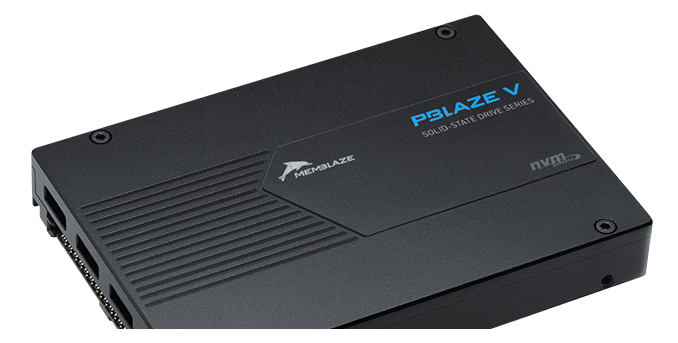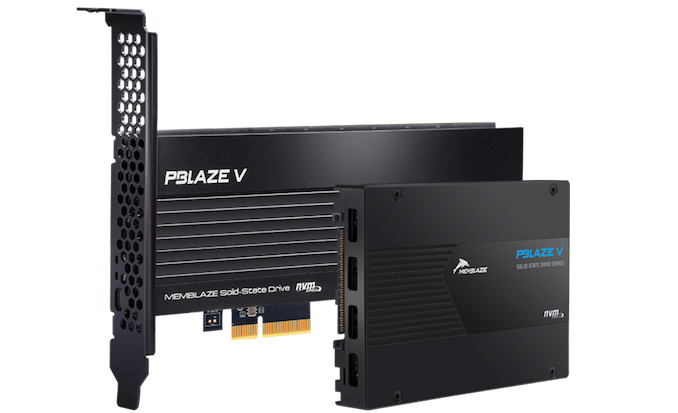Memblaze Releases New PBlaze5 520 Series Low-Power Enterprise SSDs
by Andrei Frumusanu on July 30, 2020 2:00 PM EST
Yesterday we saw Memblaze introducing a new series of low-power server-class NVMe SSDs that focus on providing excellent performance whilst maintaining lower power consumption levels, aiming at enterprises improving their storage energy efficiency. The new PBlaze5 C520, D520, C526 and D526 SSDs come in either 2.5” U.2 or HHHL form-factors in two capacity classes for each model.
Unlike its bigger brethren C900 series models which we had reviewed last year, the new 52X series units limit their performance characteristics by sticking to a PCIe 3.0 x4 interface, with all devices covered today peaking at a sequential read speed of 3.3GB/s.
The 520 models come with in either 1.92TB or 3.84TB variants, while the 526 models feature in 1.6TB or 3.2TB configurations. Random read IOPS come in at a flat 520K for all the models, whilst random write IOPS for the 520 series range from 68K on the 1.92TB unit to 70K on the 3.84TB unit. The D526 and C526 both measure in at 135K random write IOPS.
As opposed to the 900 series SKUs which either use 32- or 64-layer enterprise 3D TLC NAND, the new more energy efficient models use newer 96L chips.
The reason why’d you want to choose these lower power models is of course for deployments which require higher energy conservation or lower heat generating hardware. Compared to the 900 series, idle power consumption is reduced from 7W to down to 4W, whilst operating power reduces from 25W to 9W, with an advertised 12W peak consumption.
| Memblaze PBlaze5 Series Specifications | |||||
| PBlaze5 D520 | PBlaze5 C520 | PBlaze5 D526 | PBlaze5 C526 | ||
| Form Factors | 2.5" U.2 Drive | HHHL AIC | 2.5" U.2 Drive | HHHL AIC | |
| Interface | PCIe 3.0 x4 | PCIe 3.0 x4 | PCIe 3.0 x4 | PCIe 3.0 x4 | |
| Capacities | 1.92TB 3.84TB |
1.6TB 3.2TB |
|||
| Controller | unspecified 8-channel (likely Microchip Flashtec NVMe 2108) | ||||
| Protocol | NVMe 1.3 | ||||
| NAND | 96L 3D Enterprise TLC NAND memory (likely Micron) | ||||
| Sequential Read | 3.3 GB/s | 3.3 GB/s | 3.3 GB/s | 3.3 GB/s | |
| Sequential Write | 1.7 GB/s | 1.9 GB/s | 1.7 GB/s | 1.9 GB/s | |
| Random Read (4 KB) IOPS | 520,000 | 520,000 | 520,000 | 520,000 | |
| Random Write (4 KB) IOPS | 68,000 70,000 |
135,000 | |||
| Latency Read | 85 µs | ||||
| Latency Write | 15 µs | ||||
| Power | Idle | 4 W | |||
| Operating | 9 W typical, 12W max | ||||
| Endurance | 1 DWPD | 3 DWPD | |||
| Dual-Port Support | Yes | ||||
| Encryption | AES-256 | ||||
| Power Loss Protection | Yes | ||||
| MTBF | 2 million hours | ||||
| Additional Information | Link | ||||
Pricing is not publicly listed for the new 500 series as it’s dependent on the customer order and the exact drive configuration required – the products are now available for enterprise customers.
Related Reading:
- Enterprise NVMe Round-Up 2: SK Hynix, Samsung, DapuStor and DERA
- The Memblaze PBlaze5 C916 Enterprise SSD Review: High Performance and High Capacities
- The Memblaze PBlaze5 C916 Enterprise SSD Review: High Performance and High Capacities
- Memblaze Launches PBlaze5 SSDs: Enterprise 3D TLC, Up to 6 GB/s, 1M IOPS, 11 TB











2 Comments
View All Comments
Dragonstongue - Thursday, July 30, 2020 - link
I would imagine power use idle and or in use would be that much lower power use then it is, I am aware when talking the "edges" of things where wins are often counted in the 1000s of a second and all thatstill, that seems quite a bit of power when there are "consumer" level ones ( 2280 and such drives) that are getting similar if not superior performance, sometimes capacity, certainly better in the wattage range considering
maybe due to extra something something needed that chews extra power or ??
example I am using for high performance, total endurance etc, Samsung 970 Pro, seems they have managed higher overall performance for a little less overall power figures as well (maybe the enterprise are designed to be 24/7 vs even the sammy "Pro" is not (just a higher grade then normal stuff ?)
Billy Tallis - Thursday, July 30, 2020 - link
The biggest reason enterprise drives have high idle power is that they don't really have any kind of sleep state. Waking up from sleep is a relatively slow process for consumer SSDs, and it's enough of a pause to completely ruin the latency metrics that enterprise drives aim for. Even with sleep states disabled, we usually don't see 8-channel consumer NVMe drives pull much more than 1W at idle, so 4W here is clearly a lot higher. But it's definitely in line with competing enterprise drives (eg. Samsung 983 DCT idling around 4W for U.2, 2.6W for M.2).